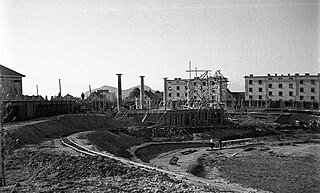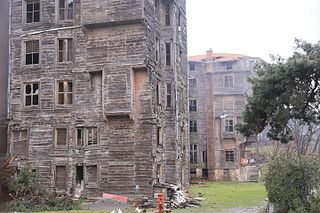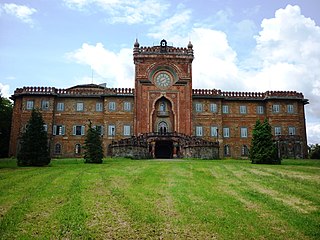 W
WThe Amphitheatre of Durrës is a Roman amphitheatre in the centre of the city of Durrës, Albania. Construction began under the emperor Trajan in the 2nd century AD and it was destroyed twice by earthquakes in the 6th and 10th centuries. It is the largest amphitheatre ever built in the Balkan Peninsula with once having a capacity of 20,000 people.
 W
WThe Belgrade Fortress, consists of the old citadel and Kalemegdan Park on the confluence of the Sava and Danube rivers, in an urban area of modern Belgrade, Serbia. It is located in Belgrade's municipality of Stari Grad. Belgrade Fortress was declared a Monument of Culture of Exceptional Importance in 1979, and is protected by the Republic of Serbia. It is the most visited tourist attraction in Belgrade, with Skadarlija being the second. Since the admission is free, it is estimated that the total number of visitors is over 2 million yearly.
 W
WBežigrad Stadium, also known as Bežigrad Central Stadium, is a multi-purpose stadium in Ljubljana, Slovenia. It is the oldest stadium in Ljubljana. The stadium has been closed since 2008.
 W
WBourla Theatre is a theatre located in Antwerp that seats around 900. The building is designed in a neoclassical style on the site of the former Tapissierspand tapestry market. The theatre was designed on request from the city in 1827 by the city architect Pierre Bourla. Construction began in 1829, but was delayed due to the Belgian Revolution. The theatre was finally finished in 1834 and opened under the name, Grand Théâtre or Théâtre Royal Français, on account of its ownership by a French company. Presently, the Bourla houses the theatre company Het Toneelhuis, which is a merger of the companies, Koninklijke Nederlandse Schouwburg and Blauwe Maandag Compagnie.
 W
WThe Prinkipo Greek Orphanage is a historic 20,000-square-meter wooden building on Büyükada, one of the nine Princes' Islands off the coast of Istanbul, Turkey, in the Sea of Marmara. It is considered the largest wooden building in Europe and second largest in the world. It served as an orphanage from 1903 to 1964.
 W
WThe Monument House of the Bulgarian Communist Party, also known as the Buzludzha Monument, was built on Buzludzha Peak in central Bulgaria by the Bulgarian communist government and inaugurated in 1981. It commemorated the events of 1891, when a group of socialists led by Dimitar Blagoev assembled secretly in the area to form an organized socialist movement that led to the founding of the Bulgarian Social Democratic Party, a forerunner of the Bulgarian Communist Party.
 W
WThe Cittadella of Alessandria is a star fort and citadel in the city of Alessandria, Italy. It was built in the 18th century by the Kingdom of Sardinia, and today it is one of the best preserved fortifications of that era. It is one of the few fortifications in Europe still in their original environment, since there are no buildings blocking the views of the ramparts, or a road that surrounds the ditches.
 W
WThe Constanța Casino is a defunct casino, located in Constanța, Romania. It has been designated by the Romanian Ministry of Culture and National Patrimony as a historic monument. The casino is on the Constanța seafront at 2 Elisabeta Boulevard along the Black Sea in the historic Peninsulă District of the city. The casino was built three separate times, with the first structure being erected of wood in 1880. It was designed to be a club and community center for elite and upper-class socialites willing to spend. Once considered Romania's Monte Carlo and a symbol of the city of Constanța, the most-recent and modern version was built in Art Nouveau style, also being the most important Art Nouveau building in the country, designed and built according to the plans of Daniel Renard and inaugurated in August 1910. The most modern version of the Casino was in operation for 38 years, with interruption due to the two world wars, attacked and bombed by Bulgarian and German troops in World War I, ravaged in World War II and, at one point, acted as a makeshift wartime hospital. In 1948 it was taken over by the Communist government becoming a House of Culture (Casa de Cultură a Sindicatelor) for the party until 1960 when it was handed to the National Office of Tourism (Oficiul National de Turism ). The last major repairs took place in 1986–1988, and the building was abandoned until 2019 and currently it's under renovation again.
 W
WDavid Gareja is a rock-hewn Georgian Orthodox monastery complex located in the Kakheti region of Eastern Georgia, on the half-desert slopes of Mount Gareja on the edge of Iori Plateau, some 60–70 km southeast of Georgia's capital Tbilisi. The complex includes hundreds of cells, churches, chapels, refectories and living quarters hollowed out of the rock face.
 W
WThe Fortifications of Vauban is made up of 12 groups of fortified buildings and sites along the borders of France. They were designed by military architect Sébastien Le Prestre de Vauban (1633–1707) during the reign of King Louis XIV, and were added in 2008 to the list of UNESCO World Heritage Sites.
 W
WThe Grimsby Ice Factory is a former factory located in Grimsby, England, that was constructed from 1898–1901 to provide crushed ice to preserve fish stored in ships at Grimsby's seaport. The Grimsby Ice Factory engaged in operations up to 1990. The buildings still contain some of the original historic machinery from times of the operations' origins. During its time of prime operations, it produced 1,200 tonnes of ice daily. The building is 4,350 square metres in size, and at one time it was the largest ice factory in the world. The building is deteriorating, and it has been stated that it will eventually crumble if restoration efforts are not undertaken. Furthermore, historic machinery at the site is at risk from exposure to the elements, because the roof is not watertight.
 W
WHasankeyf is an ancient town and district located along the Tigris River in the Batman Province in southeastern Turkey. It was declared a natural conservation area by Turkey in 1981.
 W
WHelsinki-Malmi Airport is an airport in the city of Helsinki, Finland, located in the district of Malmi, 5.4 NM north north-east of the city centre. Until the opening of Helsinki-Vantaa Airport in 1952, it was the main airport of Helsinki and also Finland. Used actively in general aviation and flight training for decades, flight operations were suspended with the closure of the last active runway on 14 March 2021, and the future of the airport remains uncertain. Before the current suspension of operations, Malmi was still the second-busiest airport in Finland after Helsinki Airport, as measured by the number of landings.
 W
WThe Monastery of Jesus is a historical religious building in Setúbal, Portugal, which served a monastery of Poor Clare nuns. It is one of the first buildings in the Manueline style, the Portuguese version of late Gothic. The cloisters of the complex houses a museum of the monastery.
 W
WThe Palace of Mafra, also known as the Palace-Convent of Mafra and the Royal Building of Mafra, is a monumental Baroque and Neoclassical palace-monastery located in Mafra, Portugal, some 28 kilometres from Lisbon. Construction began in 1717 under King John V of Portugal and was completely concluded in 1755.
 W
WLe Mont-Saint-Michel is a tidal island and mainland commune in Normandy, France.
 W
WThe National Theatre of Albania was the main theatre in Tirana, Albania. In March 2020, the National Theatre of Albania was selected by Europa Nostra among the 7 most endangered monuments in Europe, as an exceptional example of modern Italian architecture from the 1930s and one of the most prominent cultural centers in Albania, facing impending threat of demolition. On 17 May 2020, the National Theatre building was demolished.
 W
WPatarei Prison, also known as Patarei Sea Fortress and Tallinn Central Prison, commonly known as The Battery (Patarei), is a building complex in Kalamaja district of Tallinn, Estonia. The premises cover approximately four hectares of a former sea fortress and prison, located on the shore of Tallinn Bay.
 W
WThe Abbey of San Benedetto in Polirone is a large complex of Benedictine order monastic buildings, including a church and cloisters, located in town of San Benedetto Po, Province of Mantua, Region of Lombardy, Italy. The complex, now belonging to the city, houses offices, a museum, and is open to visitors.
 W
WSammezzano, or the Castle of Sammezzano, is an Italian palazzo in Tuscany featuring Moorish Revival architectural style. It is located in Leccio, a hamlet of Reggello, in the Province of Florence.
 W
WThe Jakab and Komor Square Synagogue in Subotica is a Hungarian Art Nouveau synagogue in Subotica, Serbia. It is the second largest synagogue in Europe after the Dohány Street Synagogue in Budapest. It was built in 1901-1902 during the administration of the Kingdom of Hungary, according to the plans of Marcell Komor and Dezső Jakab replacing a smaller and less elaborate synagogue. It is one of the finest surviving pieces of religious architecture in the art nouveau style. It served the local Neolog community.
 W
WSzombierki Power Station is a coal-fired power station in Szombierki district of Bytom, Poland. Operational since 1920, since the 1990s it operates at a limited capacity, and is regarded as a monument due to its architectural values.
 W
WThe United Nations Buffer Zone in Cyprus is a demilitarized zone, patrolled by the United Nations Peacekeeping Force in Cyprus (UNFICYP), that was established in 1964 and extended in 1974 after the ceasefire of 16 August 1974, following the Turkish invasion of Cyprus, and the de facto partition of the island into the area controlled by the Republic of Cyprus and the largely unrecognized Turkish Republic of Northern Cyprus in the North. The zone, also known as the Green Line, stretches for 180 kilometres from Paralimni in the east to Kato Pyrgos in the west, where a separate section surrounds Kokkina.
 W
WThe Venetian Lagoon is an enclosed bay of the Adriatic Sea, in northern Italy, in which the city of Venice is situated. Its name in the Italian and Venetian languages, Laguna Veneta—cognate of Latin lacus, "lake"—has provided the English name for an enclosed, shallow embayment of salt water, a lagoon.